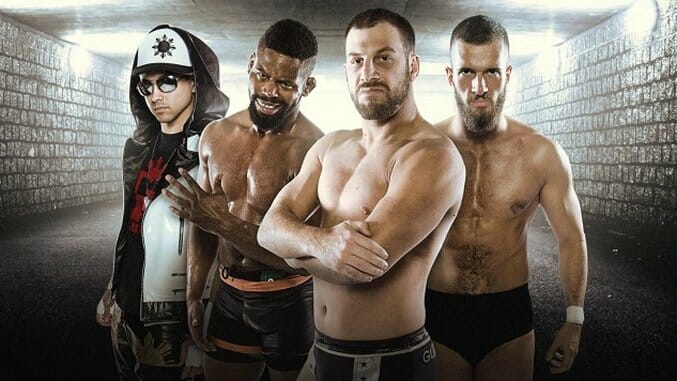WWE’s Cruiserweight Classic Is an Exciting Glimpse of a More Serious WWE
It Feels Real to Me

Kota Ibushi was wrestling his first match for WWE and for a second I thought somebody had died. His opponent tried to do a springboard tope con hilo, a convoluted move where he sprints towards the ropes inside the ring, jumps onto the second rope, and then does a flip over the top rope and onto his opponent on the floor below. Somewhere along the way physics crossed the man up and his foot seemed to get caught up by the top rope; instead of springing over it and doing a full rotation, his body quickly snapped downward and he seemed to land face-first on top of Ibushi below. From my vantage point, on the other side of the ring, it seemed very likely somebody was going to be hurt, perhaps seriously.
Fortunately both wrestlers quickly stood up and continued the match. Neither of them seemed off or unsteady the rest of the match. They continued to pinball off each other, driving each other into the mat and the turnbuckle, and the match ended with no more mishaps. When the match eventually airs on the WWE Network in the next four weeks, during the first round of the inaugural Cruiserweight Classic tournament, it’s entirely possible this exchange will be removed or smoothed out via editing.
![]()
The Cruiserweight Classic starts on the WWE Network tonight, but the first round was taped three weeks ago in Orlando. The tournament is a big deal for wrestling fans, not just because it brings some of the best talent in the world together, but because it represents a signal shift in how WWE, the dominant force in the wrestling industry, views and presents its product. The company is known for promoting itself as “sports entertainment,” for avoiding the word “wrestling,” for acting like the rest of the industry doesn’t exist, and for historically prioritizing oversized, body-building He-Men over smaller, more talented athletes. Now it’s running a show made up of competitors from other organizations from throughout the world, with a straight sports presentation and a weight limit of 205 pounds that is being enforced through what are, by all accounts, legitimate weigh-ins. To longtime fans it is the least WWE show imaginable, and it can only be seen on the WWE Network.
The first round was taped last month in Orlando, at the same Full Sail University studio where NXT is shot, and unexpectedly I wound up in the audience. I won’t spoil any of the finishes, but I can say that, between these first 16 matches, the tournament is shaping up to be a great overview of what professional wrestling looks like in the year 2016—and I don’t just mean what you can see from Ring of Honor, CMLL, New Japan or Rev Pro, but in WWE’s signature programming, too. The Cruiserweight Classic isn’t a sign that WWE is becoming more open to smaller wrestlers working a more athletic style than it used to be—it’s just more proof that that change has already happened, and that the company has become far more open-minded in how it evaluates and signs talent than it ever was in the past.
The modern concept of a cruiserweight division might stretch back to WCW’s heyday in the mid-to-late ‘90s, when wrestlers like Eddie Guerrero, Dean Malenko and Rey Mysterio Jr. revolutionized what fans could expect from an American wrestling promotion, but the demarcation doesn’t make much sense today when you have wrestlers like Seth Rollins and AJ Styles headlining WWE pay-per-views and getting better reactions than almost anybody else on the roster. John Cena has the prototypical body-builder look Vince McMahon has always looked for, but he’s incredibly athletic in the ring, and regularly pulls off moves that would’ve largely been expected only from cruiserweights twenty years ago. Daniel Bryan is probably the most beloved WWE superstar of the last 15 years, and although WWE fought the fans on his rise as hard as the company could, he still wound up headlining WrestleMania and walking out with the World title. It’s taken a long time to reach this point, but size doesn’t matter like it once did, and in terms of in-ring action, WWE as currently configured is a legitimate contender for the title of the best wrestling promotion in the world today.
-

-

-

-

-

-

-

-

-

-

-

-

-

-

-

-

-

-

-

-

-

-

-

-

-

-

-

-

-

-

-

-

-

-

-

-

-

-

-

-








































